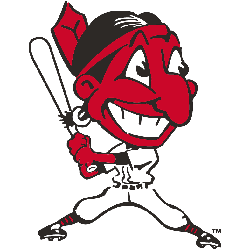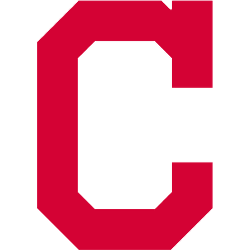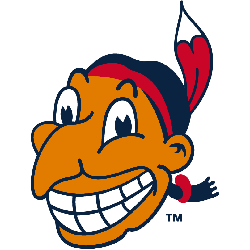Chief Wahoo does not need to be introduced as he is the classic/famous logo of the Cleveland Indians. Many modifications and types of Cleveland Indians' Chief Wahoo logos are well known.
The Cleveland Indians' Chief Wahoo story, had begun more than 75 years ago and stopped last year when Major League Baseball announced that the Indians would no longer use the divisive logo on their uniforms beginning with the 2019 season.
What is the reason of this decision? To clarify this, let us return to the origins of this logo and go all the way from its creation, popularization, different changes to the point where we are now.
Officially, Wahoo was 71 years old, however, there are still some discussions about the real date of its creation. Some baseball historians say the chief could have been as old as 119 or even as young as 66.
What does Chief Wahoo mean? Is it “just” a logo or is it something way bigger?

Cleveland Indians Primary Logo 1947 - 1950
“Chief Wahoo” was actually a fairly common nickname for any generic Indian character. In fact, there was a popular newspaper comic strip called “Big Chief Wahoo” that ran from 1936 to 1947. The name “Chief Wahoo” also appeared in the popular Cleveland sports column “The Sports Trail” by Jimmy Doyle on May 25, 1951. Also known as "The Little Indian," the strips, featuring a Native American character, was based on the results of the last days game.
The nickname “Indians” and the image of Chief Wahoo are the product of a long lineage. It is a story of a tragic player Sockalexis treated horribly by the press. He used to be the star player from May till July 1897 and sportswriters wrote poems to him in the newspaper. But once he fell into bad habits, problems with alcoholism and became utterly beyond the reach of discipline the enthusiasts, who had been his most eager admirers called him “only an Indian, after all.” And also about the superstar pitcher Allie Reynolds, who had pitched for the Indians for five years, mostly as a starter (he worked in 139 games and finished a quarter of them) and very quickly had become a fan favorite eventually had been traded away to the hated New York Yankees on October 11, 1946. Reynolds was one of the first former Indians to make a difference on successful Yankees squads.
However there are those, who called the logo racist and claimed the use of such icons discriminates against Native Americans.
Nearly every year, groups of Native Americans and their supporters have protested outside the stadium before the home opener in hopes of not only getting the team to abolish Chief Wahoo but to change the Indians' nickname, which they feel is an offensive depiction of their race.
Under growing pressure to eliminate Chief Wahoo, the club has been transitioning away from the logo in recent years. In 2014 the Indians introduced a block letter "C," a script-letter "I," and the word "Indians" written in script on some of their caps and have removed signs of the Wahoo logo in and around Progressive Field, the team's downtown ballpark. It was a small victory for activists who had long decried the image as a racist caricature.

Cleveland Indians Primary Logo 2014 - Present
Although the block letter “C” logo was used as the club’s primary logo, Chief Wahoo still has been smiling from the uniform sleeves, caps, batting helmets, and stadium decor. Let’s be honest! Could there ever be a Cleveland Indian team without Chief Wahoo? Wahoo in Cleveland is like infrastructure! it is way down in the bowels of things.
In recent decades various groups across North America have appealed to the team to renounce the logo, to no avail. But over the past year the commissioner of baseball, Rob Manfred, has pressured Paul Dolan, Cleveland’s chairman and chief executive, to make a change.
The decision to remove the logo on the Indians' uniforms coincides with Cleveland hosting the 2019 MLB All-Star Game. The Indians have indicated that MLB did not force the team to remove the logo in order to be granted the right to host the Midsummer Classic. Cleveland's pitch to hold the event began years ago, and it became a strong focus during the team's postseason run in 2016.

Cleveland Indians Alternate Logo 1947 - 1950
Regardless of where individual Clevelanders stand on whether the image is offensive, we shouldn’t argue with history or use its omissions as an excuse. The true history of Wahoo might not be the best reason to consider a change in logo or name—or even a reason to consider a change at all. The discussion about Wahoo is about more than just cartoons or nicknames. It is actually hard to imagine any Indians fan without the real Chief Wahoo symbols because he has become a classic.
But many teams still cling to the old names and likenesses despite pressure to eliminate them. And only time will show us either Chief Wahoo will vanish in eternity or still gonna live and be cherished in hearts of those, who can’t imagine their favorite team without it. Only time will tell...
Sports Logo History is a community of sports logo enthusiast who enjoys the history of each team’s logo history. Sports Logo History has primary logos, alternate logos, wordmark logos or concept logos from the NFL, NBA, MLB, MLS, NHL, Premier League, WNBA, CFL, NCAA, ABA, USFL, AAF, and XFL.
Our partner site is Sports Team History takes a look at the history of each and every professional sports team.



